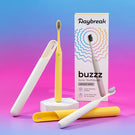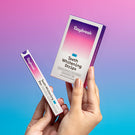What is Hydroxyapatite?
Hydroxyapatite (HA) is the main component of enamel, which gives an appearance of bright white and eliminates the diffuse reflectivity of light by closing the small pores of the enamel surface. Hydroxyapatite has long been among the most studied biomaterials in the medical field for both its proven biocompatibility and for being the main constituent of the mineral part of bone and teeth. HA represents 90% in weight of of the tooth enamel.
Since its approval as an anti-caries agent in 1993 in Japan, it has become available commercially in Europe in 2006 and in Canada in 2015. It is widely considered an effective, non-toxic alternative to fluoride which is known to cause developmental neurotoxicity as well as toxicity among adults at high levels of consumption.
Resources:
1. Healthline: What is Hydroxyapatite Toothpaste
2.Hydroxyapatite and its applications in preventive, restorative and regenerative dentistry: a review of literature
3.Ask the Dentist: Hydroxyapatite. What It is, Benefits...
What is Calcium Carbonate?
Calcium Carbonate is an organic substance that delivers multiple benefits when used in toothpaste. It can act as a gentle abrasive that eliminates surface stains from the enamel. It's also shown to eliminate greater amounts of plaque than toothpaste without Calcium Carbonate.
Calcium Carbonate is also often used as a dietary supplement and is completely safe to consume.
Resources:
1. Study: Effects of Toothpaste Containing Granular Calcium Carbonate on Oral Health
2. Tom's of Maine
3. Study published in the International Dental Journal
Why are fruit enzymes good for me?
The Daybreak Brighten Toothpaste contains fruit extracts from Papayas and Pineapples - known as Papain and Bromelain respectively. These enzymes have been clinically proven to significantly reduce surface stains from the enamel through non-abrasive action.
Unlike peroxide-based solutions, fruit enzymes are plant derived and have no side effects. In comparison peroxide based solutions can damage the protective enamel and result in tooth sensitivity.
Resources:
1. Study published in the International Journal of Dental Hygiene
2. Efficacy of Extrinsic Stain Removal by Novel Dentifrice Containing Papain and Bromelain Extracts
Why does the Restore Rinse contain minerals?
Every ingredient in Daybreak's Restore Rinse is handpicked by expert formulators. It does contain a multi-mineral complex that comprises of Zinc, Copper and Magnesium.
In the oral cavity, zinc is found in saliva, dental plaque and in the hydroxyapatite of the dental enamel. It contributes to healthy teeth formation, and plays an important role in the prevention of plaque and dental calculus formation. Zinc also contributes to the reduction of halitosis in the mouth.
Magnesium is anti-inflammatory and helps the body absorb calcium which plays a key role in tooth and bone health.
Our saliva naturally contains trace levels of copper (and zinc). Copper levels in the saliva are know to be inversely correlated with dental caries activity.
Resources:
1. The role of copper and zinc in the prevention of dental caries - A systematic review
2. Zinc Adequacy Is Essential for the Maintenance of Optimal Oral Health
3. Everything You Need to Know About Magnesium
What is L-Arginine?
Arginine is a natural component of healthy saliva. Numerous salivary microbes metabolize arginine via the arginine deiminase system (ADS), a three-enzyme pathway. An important metabolic by-product of the ADS is ammonia. If produced in sufficient amounts on a continuous basis, ammonia drives the oral pH to seven, a level that is favored by microbes that are found in healthy mouths. L-arginine has been reported to decrease the risk for dental caries.
Daily use of arginine-containing products alters the oral environment in a beneficial way. The constant production of ammonia on a cellular level causes the oral pH to rise. A neutral pH creates a hostile environment for pathogens, resulting in a healthy oral ecology. With a continuous source of arginine, pathogens either die off or become less active metabolically, allowing the oral cavity to achieve and maintain homeostasis.
Resources:
1. Arginine: A magical weapon in the war against oral microbial diseases
2.Arginine: A new and exciting approach to oral care
What is Zinc Lactate?
Zinc lactate (ZnLA) is an organic zinc salt which has antioxidant properties. Zinc salts are known to reduce oral malodor, as well as control plaque and calculus. Zinc can inhibit the formation of volatile sulphur compounds (VSC) which are the main culprits responsible for halitosis.
Is Aloe Vera actually beneficial or just a gimmick?
Aloe vera has anti-inflammatory and antibacterial properties. The plant is also rich in antioxidants. For this reason, aloe vera is commonly used to treat and relieve inflammation related to gum disease and other oral issues. Aloe vera has been found to effective in the treatment of gingivitis, periodontitis, canker sores etc.
Resources:
1. Healthline: Benefits of Aloe Vera for Your Gums
2.Benefits of Aloe vera in dentistry




